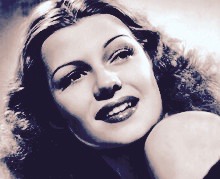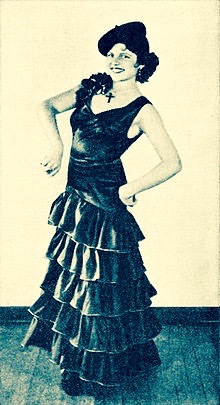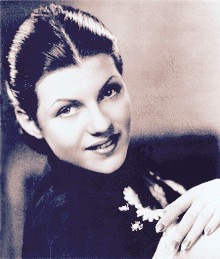Rita Hayworth

Rita Hayworth
Rita Hayworth
 Hayworth in Down to Earth (1947)
Hayworth in Down to Earth (1947)
Rita Hayworth (born Margarita Carmen Cansino; October 17, 1918 – May 14, 1987) was an American actress and dancer. She achieved fame during the 1940s as one of the era’s top stars, appearing in a total of 61 films over 37 years. The press coined the term “love goddess” to describe Hayworth after she had become the most glamorous screen idol of the 1940s. She was the top pin-up girl for GIs during World War II.
Hayworth is perhaps best known for her performance in the 1946 film noir, Gilda, opposite Glenn Ford, in which she played the femme fatale in her first major dramatic role. Fred Astaire, with whom she made two films, called her his favorite dance partner. Her greatest success was in the Technicolor musical Cover Girl(1944), with Gene Kelly. She is listed as one of the top-25 female motion picture stars of all time in the American Film Institute’s survey, AFI’s 100 Years…100 Stars.
In 1980, Hayworth was diagnosed with Alzheimer’s disease, which contributed to her death at age 68. The public disclosure and discussion of her illness drew attention to Alzheimer’s, and helped to increase public and private funding for Alzheimer’s research.
Early Life
 At age 12, Margarita Cansino was dancing professionally as her father’s partner in the Dancing Cansinos (1931).
At age 12, Margarita Cansino was dancing professionally as her father’s partner in the Dancing Cansinos (1931).
Hayworth was born in Brooklyn, New York, in 1918 as Margarita Carmen Cansino, the oldest child of two dancers. Her father, Eduardo Cansino, Sr., was from Castilleja de la Cuesta, a little town near Seville, Spain. Her mother, Volga Hayworth, was an American of Irish-English descent who had performed with the Ziegfeld Follies. The couple married in 1917. They also had two sons: Eduardo Cansino, Jr. and Vernon Cansino.
Margarita’s father wanted her to become a professional dancer, while her mother hoped she would become an actress. Her paternal grandfather, Antonio Cansino, was renowned as a Spanish classical dancer. He popularized the bolero, and his dancing school in Madridwas world-famous. Hayworth later recalled, “From the time I was three and a half … as soon as I could stand on my own feet, I was given dance lessons.” She noted “I didn’t like it very much … but I didn’t have the courage to tell my father, so I began taking the lessons. Rehearse, rehearse, rehearse, that was my girlhood.”
She attended dance classes every day for a few years in a Carnegie Hall complex, where she was taught by her uncle Angel Cansino. She performed publicly from the age of six. In 1926 at the age of eight, she was featured in La Fiesta, a short film for Warner Bros.
In 1927, her father took the family to Hollywood. He believed that dancing could be featured in the movies and that his family could be part of it. He established his own dance studio, where he taught such stars as James Cagney and Jean Harlow. During the Great Depression, he lost all his investments as commercial interest in his dancing classes waned.
In 1931, Eduardo Cansino partnered with his 12-year-old daughter to form an act called the Dancing Cansinos. Since under California law Margarita was too young to work in nightclubs and bars, her father took her with him to work across the border in Tijuana, Mexico. In the early 1930s, it was a popular tourist spot for people from Los Angeles. Because she was working, Cansino never graduated from high school, but she had completed ninth grade at Hamilton High in Los Angeles.
Cansino (Hayworth) took a bit part in the film Cruz Diablo (1934) at age 16, which led to another bit part in the film In Caliente (1935) with the Mexican actress, Dolores del Río. She danced with her father in such nightspots as the Foreign and the Caliente clubs. Winfield Sheehan, the head of the Fox Film Corporation, saw her dancing at the Caliente Club and quickly arranged for Hayworth to do a screen test a week later. Impressed by her screen persona, Sheehan signed her for a short-term, six-month contract at Fox, under the name Rita Cansino, the first of two name changes during her film career.
Career – Early Career
 Fox publicity photograph of Rita Cansino (1935)
Fox publicity photograph of Rita Cansino (1935)During her time at Fox, Hayworth was billed as Rita Cansino and appeared in unremarkable roles, often cast as the exotic foreigner. In late 1934, she performed a dance sequence in the Spencer Tracy film, Dante’s Inferno (1935), and was put under contract in February 1935. She had her first speaking role as an Argentinian girl in Under the Pampas Moon (1935). She played an Egyptian girl in Charlie Chan in Egypt (1935), and a Russian dancer in Paddy O’Day(1935). Sheehan was grooming her for the lead in the 1936 Technicolor film, Ramona, hoping to establish her as Fox Film’s new Dolores del Río.
By the end of her six-month contract, Fox had merged into 20th Century Fox, with Darryl F. Zanuck serving as the executive producer. Dismissing Sheehan’s interest in her and giving Loretta Young the lead in Ramona, Zanuck did not renew Cansino’s contract. Feeling that she had screen potential, salesman and promoter Edward C. Judson, with whom she would elope in 1937, got freelance work for her in several small-studio films and a part in the Columbia Pictures feature, Meet Nero Wolfe (1936). Studio head Harry Cohn signed her to a seven-year contract and tried her out in small roles.
Cohn argued that her image was too Mediterranean, which reduced her opportunities to being cast in “exotic” roles that were fewer in number. He was heard to say her last name sounded too Spanish. Judson acted on Cohn’s advice: Rita Cansino became Rita Hayworth when she adopted her mother’s maiden name, to the consternation of her father. With a name that emphasized her British-American ancestry, people were more likely to regard her as a classic “American.”
 Columbia Pictures publicity photograph of Rita Hayworth (1940)
Columbia Pictures publicity photograph of Rita Hayworth (1940)With Cohn and Judson’s encouragement, Hayworth changed her hair color to dark red and had electrolysis to raise her hairline and broaden the appearance of her forehead.
Hayworth appeared in five minor Columbia pictures and three minor independent movies in 1937. The following year, she appeared in five Columbia B movies. In 1939, Cohn pressured director Howard Hawksto use Hayworth for a small but important role as a man-trap in the aviation drama Only Angels Have Wings, in which she played opposite Cary Grant and Jean Arthur. With this film’s box-office success, fan mail for Hayworth began pouring into Columbia’s publicity department. Cohn began to see Hayworth as his first and official new star. The studio never officially had stars under contract, except for Jean Arthur, who was trying to break with it.
Cohn began to build up Hayworth in 1940 in features such as Music in My Heart, The Lady in Question, and Angels Over Broadway. That year, she was first featured in a Life magazine cover story. Cohn loaned Hayworth to Metro-Goldwyn-Mayer to appear in Susan and God opposite Joan Crawford. While on loan to Warner Bros., Hayworth appeared as the second female lead in The Strawberry Blonde (1941), opposite James Cagney. Because the film was a big box-office success, Hayworth’s popularity rose and she immediately became one of Hollywood’s hottest actresses. So impressed was Warner Bros., they tried to buy Hayworth’s contract from Columbia, but Cohn refused to release her. To read more about Rita Hayworth go to the link below.

